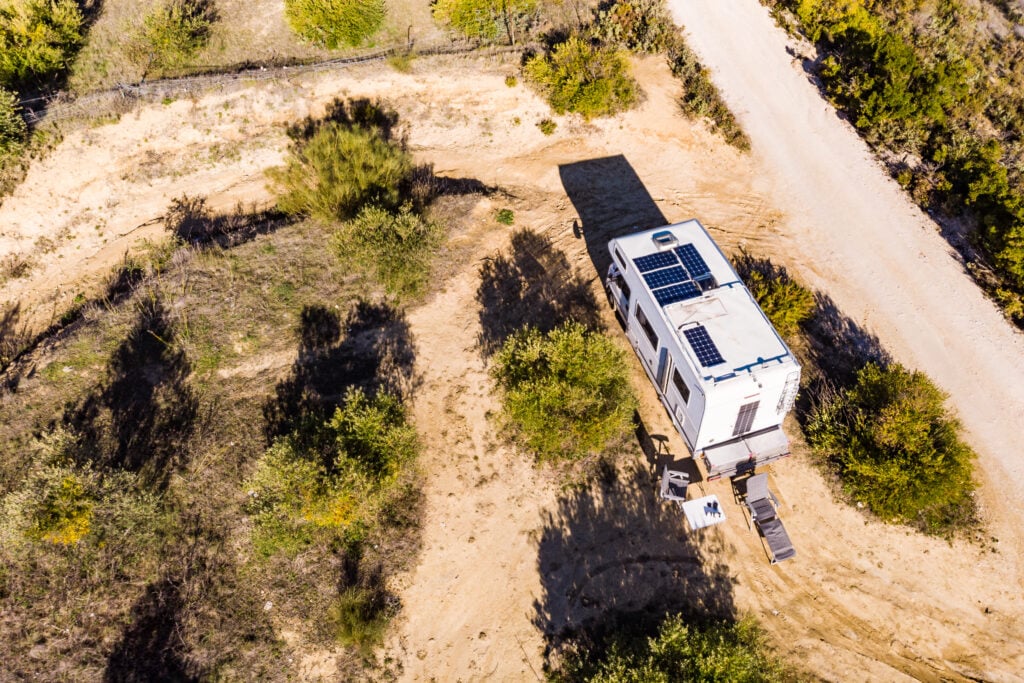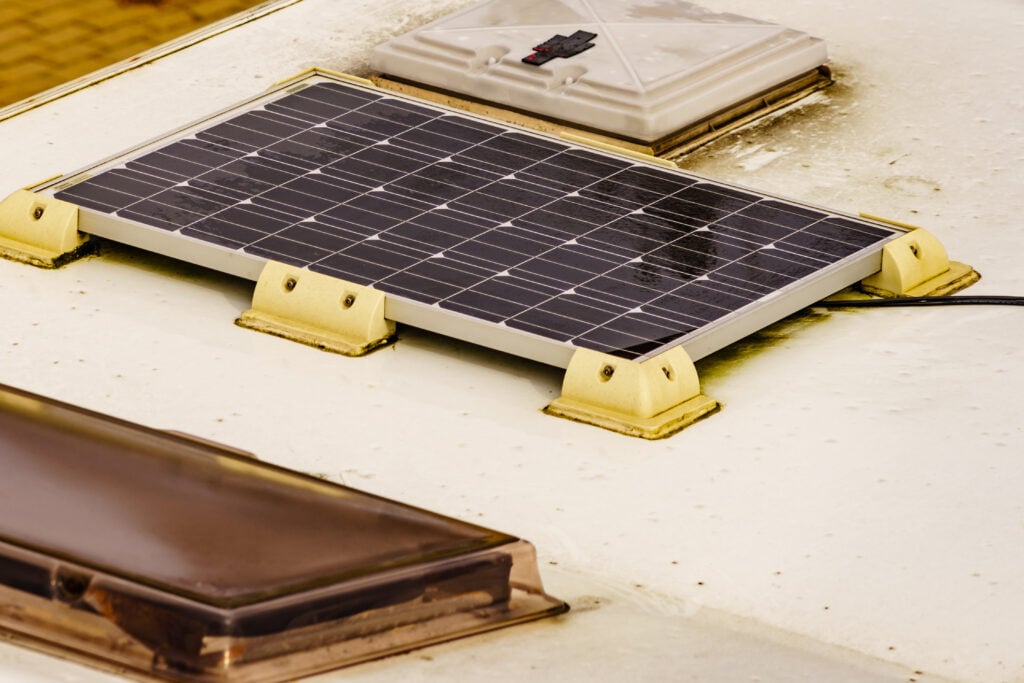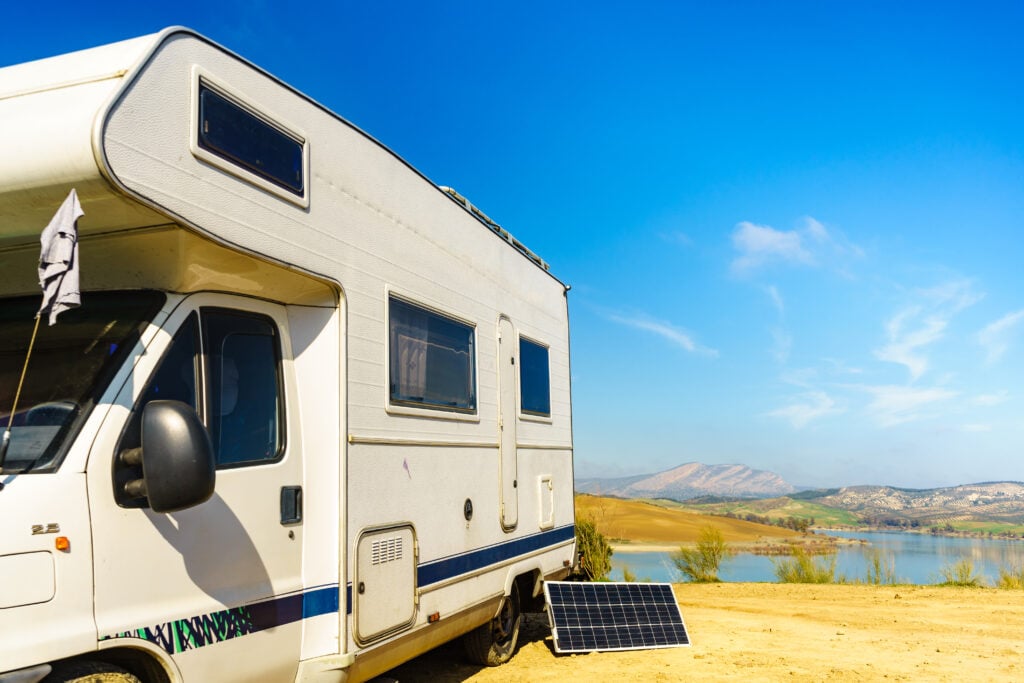
Here’s How to Avoid the Most Common RV Solar Mistakes
I get lots of questions about our RV solar and battery system. The RV solar system is large and obvious on our roof. Unless air conditioning is required where we are camping, our solar panels provide for all our energy needs.
In fielding these questions, I have determined that many solar installations do not achieve the desired outcome. Here is my list on how to avoid the most common RV solar mistakes.
1. Buying RV solar panels you don’t need or won’t use
Buying solar you don’t need or won’t use is the most obvious error. If all you do is travel from RV park with hookups to RV park with hookups, you don’t need solar panels to recharge your batteries. Your batteries will recharge just as well and probably faster using the power at your destination.
If you occasionally spend the night without hookups during a quick stop on a longer journey, I would argue for more or larger batteries, not for solar panels.
When you start spending more than one day in a row camping at locations without electrical hookups, this argues for recharging your batteries with solar panels. Then the question becomes, how often do you camp this way? If only once or twice a summer, then a generator might be a better, less expensive answer. If you do get a generator, get a quiet one.
If your battery discharges overnight to a point of concern, you need a larger capacity battery or a lower draw from the battery. This does not argue for a solar panel to recharge your battery in the daytime.
Instead of RV solar or a generator, you could use your truck engine and alternator as a generator. Be careful here, small engine alternators are not designed to provide long-duration high amperage battery recharging. Be especially careful with this option with lithium batteries; they don’t resist the charge and can damage an alternator quickly.
2. Guessing at what you need
Most people don’t have any idea about how much electricity they use. The best way to tell how much electricity you use from a battery is by measuring consumption using a shunt-based battery monitor. I did this before installing solar on my two different RVs.
My choice is a Victron 712 model that reports discharge to my cell phone. A slightly less expensive option is the Victron Smart Shunt. There are even less expensive shunt-based battery monitors, but I don’t have any experience with them. If the battery monitor does not have a shunt, then choose a different product. Once you have a shunt-based monitor, then you can measure your electricity use. If you are only using voltage to determine usage, you are simply guessing. Here is an entire article on that subject: Battery monitor — the missing critical part.
Guessing is not a good substitute for measuring.
Once you know how much electricity you use, then you can start designing your RV solar system. Start designing by figuring out your battery size. A good rule of thumb is to size your battery so that you can operate for 24 hours without recharging. Once you have enough battery to run 24 hours, you can then determine how many solar panels you need to perform the recharge.
3. Installing panels that are not exposed to full sun
Any little shade kills the energy production of the panel. It is better to have a poor orientation on the panels than it is to have shade on the panels. Depending on how your system is wired, shade on one panel can even kill the energy production of the adjoining panel.
Solar panels are designed to sit in the direct sun. When they are in the shade, they sometimes can produce only 10% of their potential energy.
4. Installing panels flat on your roof
If solar panels are installed flat to the roof, their operating temperature will increase, and as this happens the output of the panel will decrease. The effect isn’t quite the disaster that installing panels in the shade is, but they will not perform nearly as well without air circulation behind the panel.

Be sure to allow for airflow under and around your solar panel.
5. Failure to account for true performance and expansion
Almost always, due to less than ideal orientation, your solar panel needs to be oversized by a factor of about 30%. If the panel says 100-watt output, you can count on about 70 watts of usable power per hour during the peak exposure hours, which is about five hours per day, even in the winter. Summer will give you about two extra peak exposure hours. Don’t expect a 100-watt panel to produce 500-watt/hours of usable energy each day.
Lead-acid batteries also degrade solar panel performance because they resist being charged. My guess is that when I was charging lead-acid batteries using my first solar panel system, I cut solar performance by more than half.
A good practice would be to run wire with the idea that someday in the future you may want to add more solar panels to your system.
6. Cheap RV solar panels
Solar panels should last 20 years. Some of the least expensive solar panels will only last a few years. Solar cells are extremely thin and since they are so thin, they do not tolerate vibration well.
Solar cells are about the same price regardless of where they are manufactured. Since the actual solar cells themselves are all about the same price, you have to ask yourself, “Why is this RV solar panel less expensive than a different panel?”
Did they cut corners on the aluminum frame, glass, or backing? Solar panels should be robust enough to keep vibrations to a minimum at the cell level. Cheap solar panels may cost more in the long run. I recommend higher quality RV solar panels with a good warranty by a company that has been doing it for a long time.
7. Cheap RV solar controllers
RV solar controllers are another place where installers try to cut costs. Does the controller have a large heat sink to dissipate extra energy? A good way to judge a controller is by its weight. It should be heavy. It should not have a fan. Fans fail and then the controller will overheat and die.
An aluminum heat sink doesn’t fail. A good solar controller may cost two or three times the price of the cheap models. I expect my controllers to never fail. Cheap solar controllers typically don’t last very long.
8. Cheap batteries
If you go to a big box store and buy a “deep cycle” RV/marine battery, you probably purchased a bad battery. Sealed lead-acid batteries are not good batteries for solar storage. The electrolyte in a flooded sealed lead acid battery will be gone just after the warranty expires.
Flooded lead-acid deep cycle batteries with refill caps can be good batteries. AGM batteries are good batteries. Here is an entire article on lead-acid batteries: Stop Using The Wrong Deep Cycle RV Battery
Batteries made from lithium iron phosphate are the very best deep cycle batteries. This is the ultimate deep cycle. They have much longer life spans, and when judged on life cycle costs are the least expensive batteries you can buy — but they cost lots more upfront. Here is an entire article on lithium iron phosphate batteries: Batteries Lead or Lithium
9. Undersized wires
The minimum wire size for any solar panel installation should be 10 gauge. Thicker wires, including very thick wires, and wires bigger around than your thumb (4/0 gauge) may be required in some locations.
It is so sad to see good solar panels incorrectly wired with thin wires. It makes you wonder how they messed this simple item up. Edison discovered that DC electrical systems didn’t work to power neighborhoods all because they were trying to use thin wires over long distances. Use the correct wires, which usually means thick wires.
Another obvious wire mistake is using indoor wire outside. Wires meant for interior use will degrade and be worthless in about a year when exposed to direct sunlight.
10. Too much weight
This problem can apply to solar panels, solar panel racks, and other stuff, but really the problem here is lead-acid batteries. Lithium batteries of the same size and shape almost always hold twice the energy as a lead-acid battery at less than half the weight of a lead-acid battery.
Given that lithium iron phosphate batteries are also the lowest cost batteries in the long run, and always work better than lead-acid batteries, the weight savings alone justify the cost. Here is a cost analysis of lead-acid batteries vs lithium batteries: Batteries Lead or Lithium
11. Ignoring portable RV solar panels
Portable RV solar panels have a huge advantage over fixed solar panels because you can point them at the sun. You can even track the sun as the day progresses to get much more energy from them than fixed panels ever could produce. Plus, you can park your RV in the shade and move the panels out into the sun. Here is an entire article on this subject: Portable Solar Panels

Don’t ignore the possibility of a portable RV solar panel.
12. Failure to have a backup power source
I can recharge my batteries from either solar or my generator (or both at the same time). In fact, I put the batteries in first and lived with them for eight months before I installed solar.
Here is an entire article about how to use your generator with solar: How To Use The Generator With Solar.
Here is an article on how to use your generator to recharge your batteries and live without solar: Boondocking Without Solar
Conclusion
Mistakes cost money; make a minor error and performance will suffer. Make the wrong mistake and the entire system won’t work, or won’t work for very long. I haven’t even addressed the most basic mistakes of not including fuses and switches in the right location. Avoiding mistakes in RV solar is not difficult but it requires diligence.
RVers looking for valuable how-to information have learned to go to the experts. Forums such as iRV2.com and blog sites like RV LIFE, Do It Yourself RV, and Camper Report provide all the information you need to enjoy your RV. You’ll also find brand-specific information on additional forums like Air Forums, Forest River Forums, and Jayco Owners Forum.
Related articles:
- Go Off-The-Grid With These Lightweight RV Solar Panels
- 5 Reasons You Should Switch To Portable Solar Power
- Understanding Lithium Batteries For Your RV Solar Power Solutions

The blog “HANDYBOBSOLAR” provides a wealth of information from a guy who has been using solar in his RV and off grid home for over TWENTY YEARS, he documents his experiences along the way. Ps he is a bit eccentric and a bit of cranky pants
You are so off about the use of solar panels. How can you every compare running down your battery, using a generator or plugging into your truck to solar. We sit all day with our free solar comfortably using our electric items (tv, fans, lights etc.) and not have to worry about anything!!!
I’m full time in a Roadtrek class b. I replaced the noisy gas hog Onan with a Honda 2200i. I built a custom rack on the back where the generator is inside a compartment until I need it. Then I unlock the door and slide it out. Most of the time it only has to run for several minutes as I nuke something in the microwave, so I can leave it locked on the carriage. If it needs to run a longer time I unlock it and place it on the ground where the exhaust will be blowing away from me. This has worked great for me now for three years.
It was not mentioned, if I change to lithium iron phosphate batteries, do I need to change out the converter that is keeping my batteries charged, to a lithium iron phosphate battery compatible converter
Scott, thanks for the great write up! So much applies to boating, and I was just discussing many of these items today with a fellow boater. I too am a fellow Navy pilot.. wings 4/81, E-2’s west coast.
Depends on your solar controller and your converter look them up or get there paperwork out and read the specs my controller and converter were fine to. Use with lithium batteries
How would you suggest an RV owner charge their batteries with when the unit is parked in outside storage?
There is a small solar battery charger with controller (so it will trickle charge and/or shut down when the batteries are fully charged) for sale at Batteries Plus, most auto parts stores and on Amazon. I have also seen them at RV stores but they cost more. Make sure the charger and controller are for your specific type of battery. For example, Auto parts stores are more likely to only have a solar charger whose controller is for a gel or lead acid auto battery.
My son-in-law is a full timer. He can use information such as this
Hi Scott – I have a 1960 Vintage travel trailer this is going in for a restoration/remodel early next year and adding solar for boondocking is on the list. My ex-boyfriend had this all figured out but since we are not together anymore I’m trying to figure this out on my own. I definitely learned a few things from him and your article is a great guide and supplement for me as I navigate this on my own. Per your suggestions I will start with a battery monitor with Lithium batteries and see how much power I’m using first. I also love the idea of portable panels vs installed on the roof. Parking in the shade and putting the panels in the sun makes perfect sense. I will be following your articles and so appreciate the way your explain things. Thank you so much. You are my new solar system guru!!
Tracy
Good advice on designing and using solar. First things first you need to determine the total watts and amperage you expect to be running at one time. This information can be found on the appliances. I boondock 90% of the time anywhere from the NW to SW with a few trips to the eastern states.
I run everything in my travel trailer including the A/C, Frig and Microwave off my solar and battery bank. I have three 330 watt REC split cell panels. The REC panels do not degrade in shade like most panels due to their “split cell” design. For batteries I have three 100ah AGM deep cycle VRLA batteries driving a 2000 watt AIMs inverter. My solar charger is a Victron 150/70. For my A/C I installed a smart start to reduce the initial power needs. Also, all wiring is 8 AWG except for paralleling the batteries and the run to the inverter which is 2 AWG.
My advice is to learn all one can than do a lot of research of parts followed by plan, plan, plan first. Research the different types of solar panels and solar chargers. Learn about batteries so you can make the best choice. It’s best to do a little overkill that to have a system that is too small. I also like lithium batteries; however, I calculated that I can change out my AGM’s four times before equaling the up front cost of lithium.
I have a portable RV Solar Panel. It has charged up the battery but suddenly nothing in the RV was working: lights, water pump, awning. I detach the solar panel from my battery and now everything works. Any ideas why?
Given where we are with climate change and energy costs, I find it disapointing how quickly the use of inefficient and highly poluting generators are recommended. In addition, over a lifecycle, generators are not more expensive per kWh than solar.
We all have to do our part, sometimes spending a little more for the greater good. An example would be if we replace windows in our house; should we spend more for insulated or not? Last I checked the payback for insulated windows was approx 20 years. Even so to save energy and reduce the use of fossil fuels most of us will spend more on insulated windows.
Too many issue with solar panels to charge your deep cycle batteries. Save the headache to get yourself a 2000 watt inverter generator to charge your batteries, and power can be had even if the sun is not shinning,like when it is overcast, raining, or at night. Now, what batteries to buy. Best is never what you want or need. If you are going a few trips a year, deep cycle lead acid battery from Walmart will suffice. Yes, there are pros and cons. But, they cost a lot less than lithium ion deep cycle batteries, and without the problem of not properly charging them. Yes, they have a better power profile than lead acid batteries, but again. they are much more expensive.
Got a question. I have two rather new lead-acid batteries in my class C. Can I link a FePO to the lead batteries to get more power between charging?
Lithium batteries can freeze. Charged lead-acid batteries don’t. Industrial (thick plate) 6V deep cycle batteries, with a good MPPT contoler (with temp sensor and shunt) will last over 10 years, at a fraction of the cost of lithium.
While Solar while camping is advantageous especially when in remote or under-serviced grounds, my key reason for Solar in the north is to keep the batteries charging in winter even when its -40 outside. A decade later the L/A batteries are functioning OK.